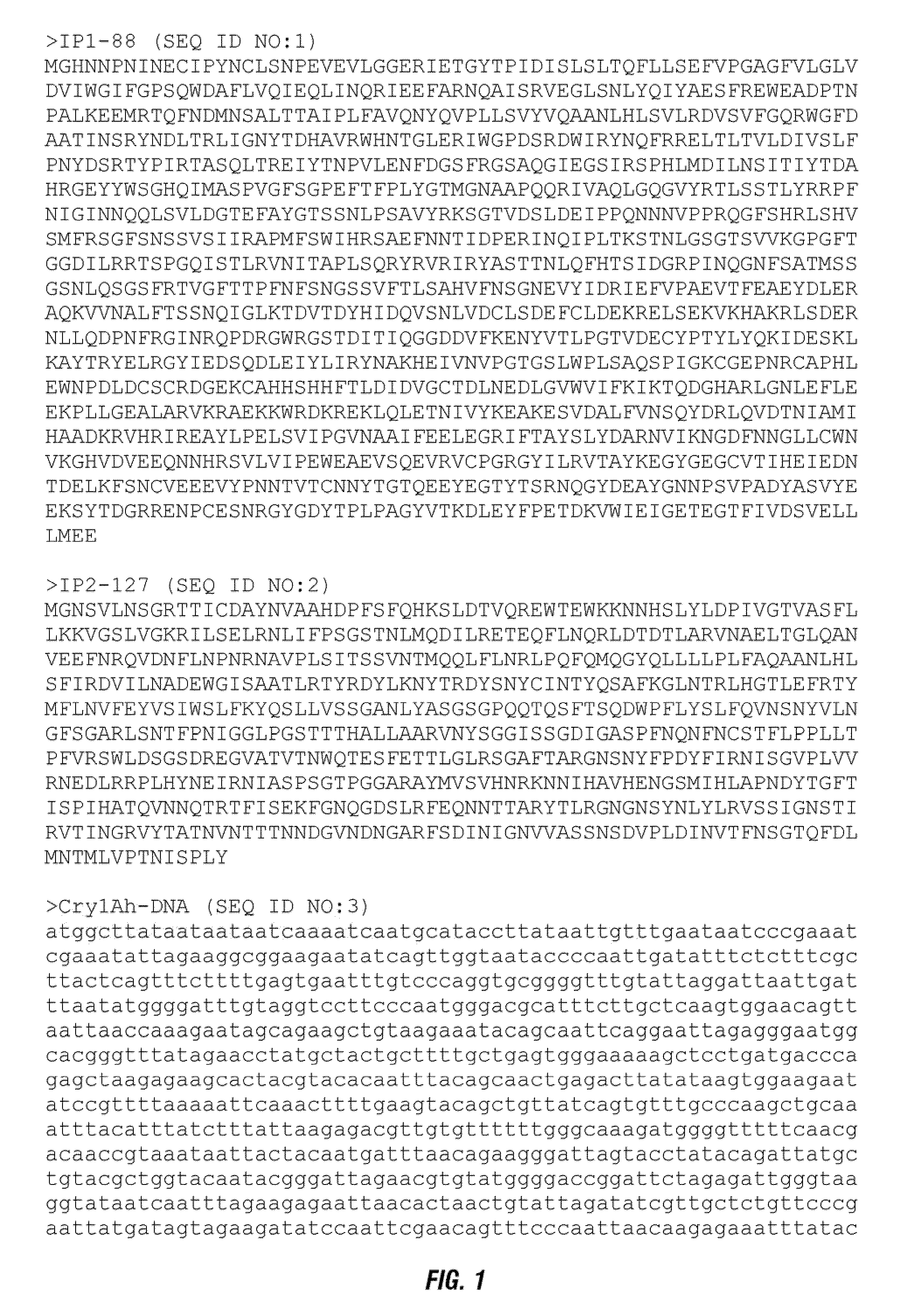Protein mixtures for maize insect control
a technology of insecticides and protein mixtures, applied in the field of pest control, can solve the problems of more potential yield losses, significant reductions in crop yield and quality, and $100 billion in crop damage, and achieve the effect of improving and synergistic insecticidal resistance against key crop pests
- Summary
- Abstract
- Description
- Claims
- Application Information
AI Technical Summary
Benefits of technology
Problems solved by technology
Method used
Image
Examples
example 1
[0090]The evaluation of potential synergism between Bt proteins IP1-88 (a Cry1) and IP2-127 (a Cry2) using the bioassay method according to Colby, S. R., Calculating synergistic and antagonistic responses of herbicide combinations, Weeds, 15(1):20-22 (1967). Bt proteins IP1-88 (a Cry1) and IP2-127 (a Cry2) were utilized as test substances to qualitatively confirm the presence and resultant effect of the Bt proteins. Evaluation of the interactive effects between the two insecticidal compounds was required to understand the effectiveness of the two toxins stacked in transgenic plants. Resultant synergy was examined using neonate larvae of European corn borer (ECB), Ostrinia nubilalis.
[0091]Standardized Lepidoptera LC50 diet incorporation bioassays were utilized to evaluate the effects of insecticidal proteins Cry1 and Cry2 on Lepidoptera larvae (referring to the immature stage of an insect between the egg and pupal stage of an insect with complete metamorphosis). All synergism experi...
example 2
[0093]Bt proteins IP1-88 (a Cry1) and IP2-127 (a Cry2), as well as additional proteins were utilized as test substances to further confirm the presence and resultant effect of the Bt proteins, according to the same methods of Example 1. Both European corn borers (ECB) and corn earworms (CEW), Helicoverpa zea, were used in the bioassays. The observed response (mortality+ss) of both ECB and CEW in two of three mixture treatments was evidently higher than expected mortality based on Colby's equation (results provided in Table 2), also indicative of synergism between IP1-88 and IP2-127 for both ECB and CEW.
TABLE 2Response (mortality + ss) of ECB and CEW caused by IP1-88 or IP2-127 alone and in mixture (n = 40, 4 d at 27° C.)Protein in singleObserved / expectedor combinationDose% responseECBCEWIP1-88R1xObserved31.619.4R2xObserved94.527.8IP2-127R1xObserved7.721.5R2xObserved20.583.8IP1-88:IP2-127R1x:1xObserved94.786.8Expected36.936.7R1x:2xObserved76.994.7Expected45.686.9R2x:1xObserved66.768....
example 3
[0094]Bt proteins Cry1Ah and IP2-127 (a Cry2), as well as additional proteins were utilized as test substances to further confirm the presence and resultant effect of the Bt proteins, according to the same methods of Example 1. Both European corn borers (ECB) and corn earworms (CEW), Helicoverpa zea, were used in the bioassays. The observed mortality and response (mortality+ss) of both ECB and CEW in the mixture treatments was higher than expected based on Colby's equation (results provided in Table 3), also indicative of synergism between Cry1Ah and IP2-127.
TABLE 3Mortality (mort) and response (resp; mortality + ss)of ECB and CEW caused by Cry1Ah or IP2-127 alone and in mixture.Protein in singleObserved / expectedECB - trial 1CEW - trial 1ECB - trial 2CEW - trial 2or combinationDose% response% mort% resp% mort% resp% mort% resp% mort% respCry1AhR1xObserved59.550.628.223.730.262.545.140.9R2xObserved77.292.266.744.730.275.070.970.4IP2-127R1xObserved28.86.921.77.959.455.311.934.9R2xObse...
PUM
| Property | Measurement | Unit |
|---|---|---|
| Tm | aaaaa | aaaaa |
| Tm | aaaaa | aaaaa |
| temperature | aaaaa | aaaaa |
Abstract
Description
Claims
Application Information
 Login to View More
Login to View More - R&D
- Intellectual Property
- Life Sciences
- Materials
- Tech Scout
- Unparalleled Data Quality
- Higher Quality Content
- 60% Fewer Hallucinations
Browse by: Latest US Patents, China's latest patents, Technical Efficacy Thesaurus, Application Domain, Technology Topic, Popular Technical Reports.
© 2025 PatSnap. All rights reserved.Legal|Privacy policy|Modern Slavery Act Transparency Statement|Sitemap|About US| Contact US: help@patsnap.com


